The Effect of Climate on the Solar Radiation Components on Building Skins and Building Integrated Photovoltaics (BIPV) Materials
Abstract
:1. Introduction
2. Materials and Methods
2.1. Solar Radiation Components
- Direct radiation is also called, “beam radiation” or “direct beam radiation”. It is used to describe solar radiation coming on a straight line from the sun, down to the surface of the earth. For sunny days with a clear sky, most of the solar radiation is direct radiation. On overcast days, the sun is shadowed by clouds, and the beam radiation is zero.
- Diffuse radiation is sunlight that has been dispersed or scattered by particles and molecules in the atmosphere and still made its way down to the surface. Diffuse radiation is commonly referred to as sky radiation because it comes from all regions of the sky. The amount of diffuse radiation is up to 100% of the total radiation for cloudy skies and 10% to 20% of the total radiation for clear skies.
- Reflected radiation is the reflection of direct and diffuse radiation on the ground. This contribution is small unless the collector is tilted at a steep angle from the horizontal, like a building façade.
2.2. Solar Radiation Spectrum
- Ultraviolet (UV) is wavelengths from 250 nm to 380 nm. UV rays are invisible to the human eyes and may be dangerous in the case of overexposure because they damage surfaces, colours and age materials.
- Visible light is wavelengths from 380 nm (violet) to 740 nm (red). Visible light rays are detectable by the human eyes and enable the sight of shapes, relief and colours.
- Short wave infrared (IR) constitutes wavelengths from 740 nm to 2500 nm. IR is invisible and is felt as heat. It constitutes most of the sun’s energy that hits the earth.
2.3. Solar Radiation Measurement Methods at the Earth’s Surface
2.3.1. Radiation Measuring Devices
- Only high-quality measurement sensors should be used.
- Measurements should be performed at a reasonable interval (at least every hour).
- Sensors should be calibrated and cleaned regularly.
- Data should be available for a long period.
2.3.2. Satellite-Based Irradiation Data
2.3.3. Climate Reanalysis Data
2.4. Locations
2.4.1. Stavanger
2.4.2. Bern
2.4.3. Rome
2.4.4. Dubai
3. Solar Radiation Analysis on Building Skins
4. Climate and Radiation
5. Climate and Technology
6. Sensitivity Analysis of Solar Irradiance and Building Orientation
7. Conclusions
Author Contributions
Funding
Institutional Review Board Statement
Informed Consent Statement
Acknowledgments
Conflicts of Interest
Nomenclature
| °C | Degree Celsius | IV | Current-Voltage |
| AM | Air mass | kWh | Kilowatt hour |
| BIPV | Building integrated photovoltaics | LiDAR | Light detection and ranging |
| BS | Building skin | mc-Si | Multi-crystalline Silicon |
| CdTe | Cadmium Telluride | nm | Nano meter |
| CIGS | Copper Indium Gallium Selenide | OSC | Organic solar cell |
| CM SAF | Satellite application facility on climate monitoring | PVGIS | Photovoltaic geographical information system |
| c-Si | Monocrystalline Silicon | PV | Power-Voltage |
| D | Direct incident radiation | Si | Silicon |
| DSC | Dye-sensitized solar cell | m2 | Square meter |
| GaAs | Gallium Arsenide | T | Total incident radiation |
| Ge | Germanium | UAE | United Arab Emirates |
| GIS | Geographic information system | UV | Ultraviolet Radiation |
| IR | Short wave infrared radiation | W | Watt |
References
- Jing Yang, R.; Zou, P.X.W. Building integrated photovoltaics (BIPV): Costs, benefits, risks, barriers and improvement strategy. Int. J. Constr. Manag. 2015, 16, 39–53. [Google Scholar]
- Osseweijer, F.J.; Van Den Hurk, L.B.; Teunissen, E.J.; Van Sark, W.G. A comparative review of building integrated photovoltaics ecosystems in selected European countries. Renew. Sustain. Energy Rev. 2018, 90, 1027–1040. [Google Scholar] [CrossRef]
- Gholami, H.; Røstvik, H.N. Economic analysis of BIPV systems as a building envelope material for building skins in Europe. Energy 2020, 204, 117931. [Google Scholar] [CrossRef]
- Gholami, H.; Sarwat, A.; Hosseinian, H.; Khalilnejad, A. Evaluation of optimal dual axis concentrated photovoltaic thermal system with active ventilation using Frog Leap algorithm. Energy Convers. Manag. 2015, 105, 782–790. [Google Scholar] [CrossRef]
- Gholami, H.; Khalilnejad, A.; Gharehpetian, G. Electrothermal performance and environmental effects of optimal photovoltaic–thermal system. Energy Convers. Manag. 2015, 95, 326–333. [Google Scholar] [CrossRef]
- Mohammadi, F.; Gholami, H.; Menhaj, M.B. Effect of ventilation on yearly photovoltaic performance. In Proceedings of the 1st International Conference on New Research Achievements in Electrical and Computer Engineering, Tehran, Iran, 13 May 2016. [Google Scholar]
- Ibrahim, A.; Fudholi, A.; Sopian, K.; Othman, M.Y.; Ruslan, M.H. Efficiencies and improvement potential of building integrated photovoltaic thermal (BIPVT) system. Energy Convers. Manag. 2014, 77, 527–534. [Google Scholar] [CrossRef]
- Agrawal, B.; Tiwari, G. Life cycle cost assessment of building integrated photovoltaic thermal (BIPVT) systems. Energy Build. 2010, 42, 1472–1481. [Google Scholar] [CrossRef]
- Shukla, A.K.; Sudhakar, K.; Baredar, P. A comprehensive review on design of building integrated photovoltaic system. Energy Build. 2016, 128, 99–110. [Google Scholar] [CrossRef]
- Esmailian, E.; Gholami, H.; Røstvik, H.N.; Menhaj, M.B. A novel method for optimal performance of ships by simultaneous optimisation of hull-propulsion-BIPV systems. Energy Convers. Manag. 2019, 197, 111879. [Google Scholar] [CrossRef]
- Biyik, E.; Araz, M.; Hepbasli, A.; Shahrestani, M.; Yao, R.; Shao, L.; Essah, E.; Oliveira, A.C.; del Caño, T.; Rico, E.; et al. A key review of building integrated photovoltaic (BIPV) systems. Eng. Sci. Technol. Int. J. 2017, 20, 833–858. [Google Scholar] [CrossRef]
- Jelle, B.P.; Breivik, C.; Røkenes, H.D. Building integrated photovoltaic products: A state-of-the-art review and future research opportunities. Sol. Energy Mater. Sol. Cells 2012, 100, 69–96. [Google Scholar] [CrossRef] [Green Version]
- Brito, M.; Freitas, S.; Guimarães, S.; Catita, C.; Redweik, P. The importance of facades for the solar PV potential of a Mediterranean city using LiDAR data. Renew. Energy 2017, 111, 85–94. [Google Scholar] [CrossRef]
- Saretta, E.; Caputo, P.; Frontini, F. A review study about energy renovation of building facades with BIPV in urban environment. Sustain. Cities Soc. 2019, 44, 343–355. [Google Scholar] [CrossRef]
- Groppi, D.; De Santoli, L.; Cumo, F.; Garcia, D.A. A GIS-based model to assess buildings energy consumption and usable solar energy potential in urban areas. Sustain. Cities Soc. 2018, 40, 546–558. [Google Scholar] [CrossRef]
- Vulkan, A.; Kloog, I.; Dorman, M.; Erell, E. Modeling the potential for PV installation in residential buildings in dense urban areas. Energy Build. 2018, 169, 97–109. [Google Scholar] [CrossRef]
- Urbanetz, J.; Zomer, C.D.; Rüther, R. Compromises between form and function in grid-connected, building-integrated photovoltaics (BIPV) at low-latitude sites. Build. Environ. 2011, 46, 2107–2113. [Google Scholar] [CrossRef]
- Yoon, S.; Tak, S.; Kim, J.; Jun, Y.; Kang, K.; Park, J. Application of transparent dye-sensitised solar cells to building integrated photovoltaic systems. Build. Environ. 2011, 46, 1899–1904. [Google Scholar] [CrossRef]
- Domjan, S.; Arkar, C.; Begelj, Ž.; Medved, S. Evolution of all-glass nearly Zero Energy Buildings with respect to the local climate and free-cooling techniques. Build. Environ. 2019, 160, 106183. [Google Scholar] [CrossRef]
- Gholami, H.; Røstvik, H.N.; Müller-Eie, D. Holistic economic analysis of building integrated photovoltaics (BIPV) system: Case studies evaluation. Energy Build. 2019, 203, 109461. [Google Scholar] [CrossRef]
- Gholami, H.; Røstvik, H.N.; Müller-Eie, D. Analysis of solar radiation components on building skins for selected cities. In Proceedings of the 14th Conference on Advanced Building Skins, Bern, Switzerland, 28–29 October 2019; pp. 541–549. [Google Scholar]
- Gholami, H.; Røstvik, H.N.; Kumar, N.M.; Chopra, S.S. Lifecycle cost analysis (LCCA) of tailor-made building integrated photovoltaics (BIPV) façade: Solsmaragden case study in Norway. Sol. Energy 2020, 211, 488–502. [Google Scholar] [CrossRef]
- Nofuentes, G.; García-Domingo, B.; Muñoz, J.; Chenlo, F. Analysis of the dependence of the spectral factor of some PV technologies on the solar spectrum distribution. Appl. Energy 2014, 113, 302–309. [Google Scholar] [CrossRef]
- Brennan, M.; Abramase, A.; Andrews, R.; Pearce, J. Effects of spectral albedo on solar photovoltaic devices. Sol. Energy Mater. Sol. Cells 2014, 124, 111–116. [Google Scholar] [CrossRef] [Green Version]
- Nofuentes, G.; De La Casa, J.; Solís-Alemán, E.M.; Fernández, E.F. Spectral impact on PV performance in mid-latitude sunny inland sites: Experimental vs. modelled results. Energy 2017, 141, 1857–1868. [Google Scholar] [CrossRef]
- Photovoltaic Geographical Information System (PVGIS). Overview of PVGIS Data Sources and Calculation Methods. Available online: https://ec.europa.eu/jrc/en/PVGIS/docs/methods (accessed on 1 January 2021).
- Amillo, A.G.; Huld, T.; Müller, R. A new database of global and direct solar radiation using the eastern meteosat satellite, models and validation. Remote Sens. 2014, 6, 8165–8189. [Google Scholar] [CrossRef] [Green Version]
- Mueller, R.; Behrendt, T.; Hammer, A.; Kemper, A. A New Algorithm for the Satellite-Based Retrieval of Solar Surface Irradiance in Spectral Bands. Remote Sens. 2012, 4, 622–647. [Google Scholar] [CrossRef] [Green Version]
- Mueller, R.; Matsoukas, C.; Gratzki, A.; Behr, H.; Hollmann, R. The CM-SAF operational scheme for the satellite based retrieval of solar surface irradiance—A LUT based eigenvector hybrid approach. Remote Sens. Environ. 2009, 113, 1012–1024. [Google Scholar] [CrossRef]
- Bollmeyer, C.; Keller, J.D.; Ohlwein, C.; Wahl, S.; Crewell, S.; Friederichs, P.; Hense, A.; Keune, J.; Kneifel, S.; Pscheidt, I.; et al. Towards a high-resolution regional reanalysis for the European CORDEX domain. Q. J. R. Meteorol. Soc. 2015, 141, 1–15. [Google Scholar] [CrossRef]
- Hennermann, K.; Berrisford, P. ERA5 Data Documentation. Copernicus Knowledge Base. 2017. Available online: https://confluence-test.ecmwf.int/display/CKB/ERA5%3A+data+documentation (accessed on 1 January 2021).
- Peel, M.C.; Finlayson, B.L.; McMahon, T.A. Updated world map of the Köppen-Geiger climate classification. Hydrol. Earth Syst. Sci. Discuss. 2007, 439–473. [Google Scholar]
- Climate-Data.org. Climate Stavanger. 2018. Available online: https://en.climate-data.org/europe/norway/rogaland/stavanger-647/ (accessed on 1 January 2021).
- Climate-Data.org. Climate Bern. 2018. Available online: https://en.climate-data.org/europe/switzerland/bern/bern-55/ (accessed on 1 January 2021).
- MeteoSwiss. Climate Normals Bern/Zollikofen Reference Period 1981−2010. Available online: https://www.meteoswiss.admin.ch/product/output/climate-data/climate-diagrams-normal-values-station-processing/BER/climsheet_BER_np8110_e.pdf (accessed on 1 January 2021).
- Climate-Data.org. Climate Rome. 2018. Available online: https://en.climate-data.org/europe/italy/lazio/rome-1185/ (accessed on 1 January 2021).
- Climate-Data.org. Climate Dubai. 2018. Available online: https://en.climate-data.org/asia/united-arab-emirates/dubai/dubai-705/ (accessed on 1 January 2021).
- Data, C. Climate of European Cities. Available online: https://www.climatedata.eu/climate.php?loc=itxx0067&lang=en (accessed on 1 January 2021).
- World Weather & Climate Information. Average Monthly Hours of Sunshine in Dubai. Available online: https://weather-and-climate.com/average-monthly-hours-Sunshine,dubai-ae,United-Arab-Emirates (accessed on 1 January 2021).
- Cornaro, C.; Andreotti, A. Solar spectral irradiance measurements relevant to photovoltaic applications. In Proceedings of the International Conference on Applied Energy (ICAE 2011), Perugia, Italy, 16 May 2011. [Google Scholar]
- National Technology and Engineering Solutions of Sandia. Spectral Response. Available online: https://pvpmc.sandia.gov/modeling-steps/2-dc-module-iv/effective-irradiance/spectral-response/ (accessed on 1 January 2021).

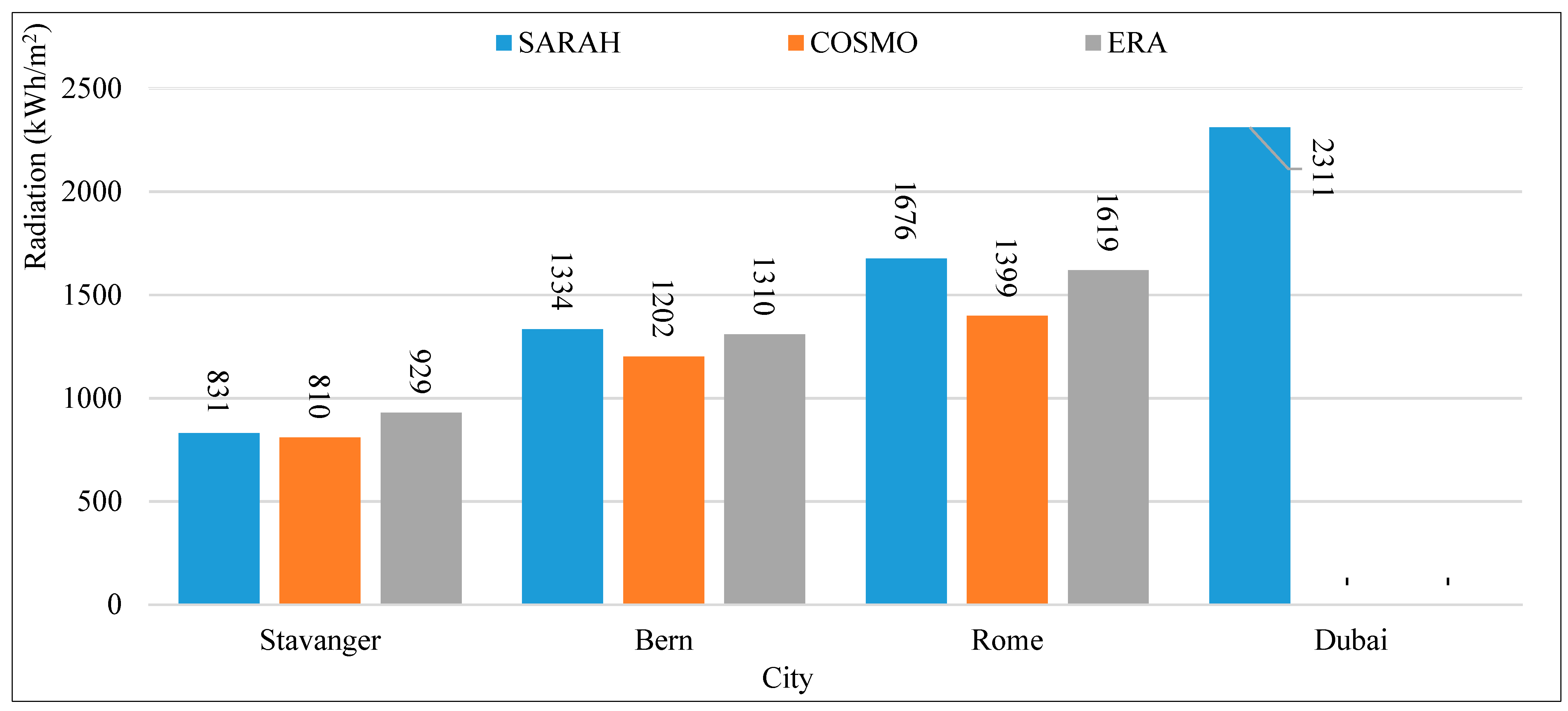


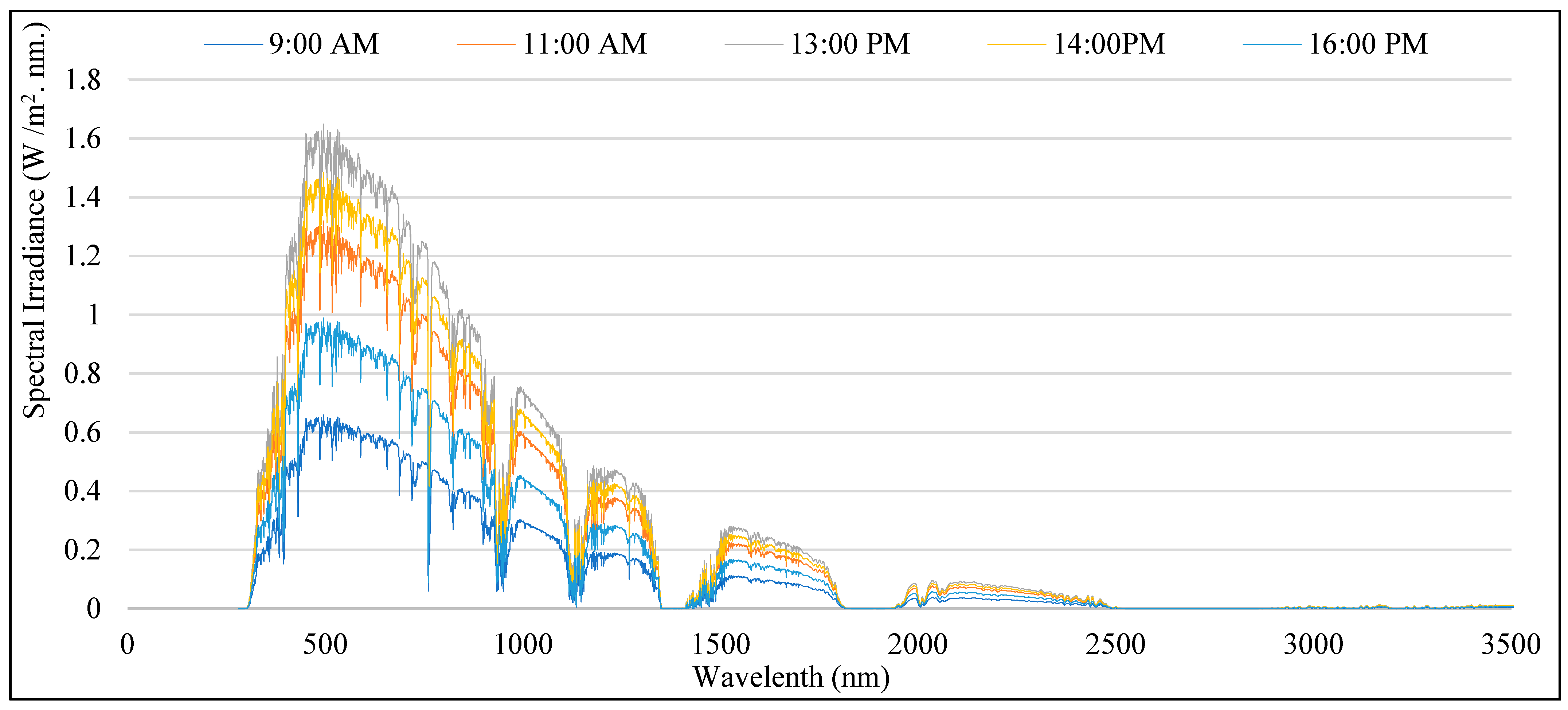
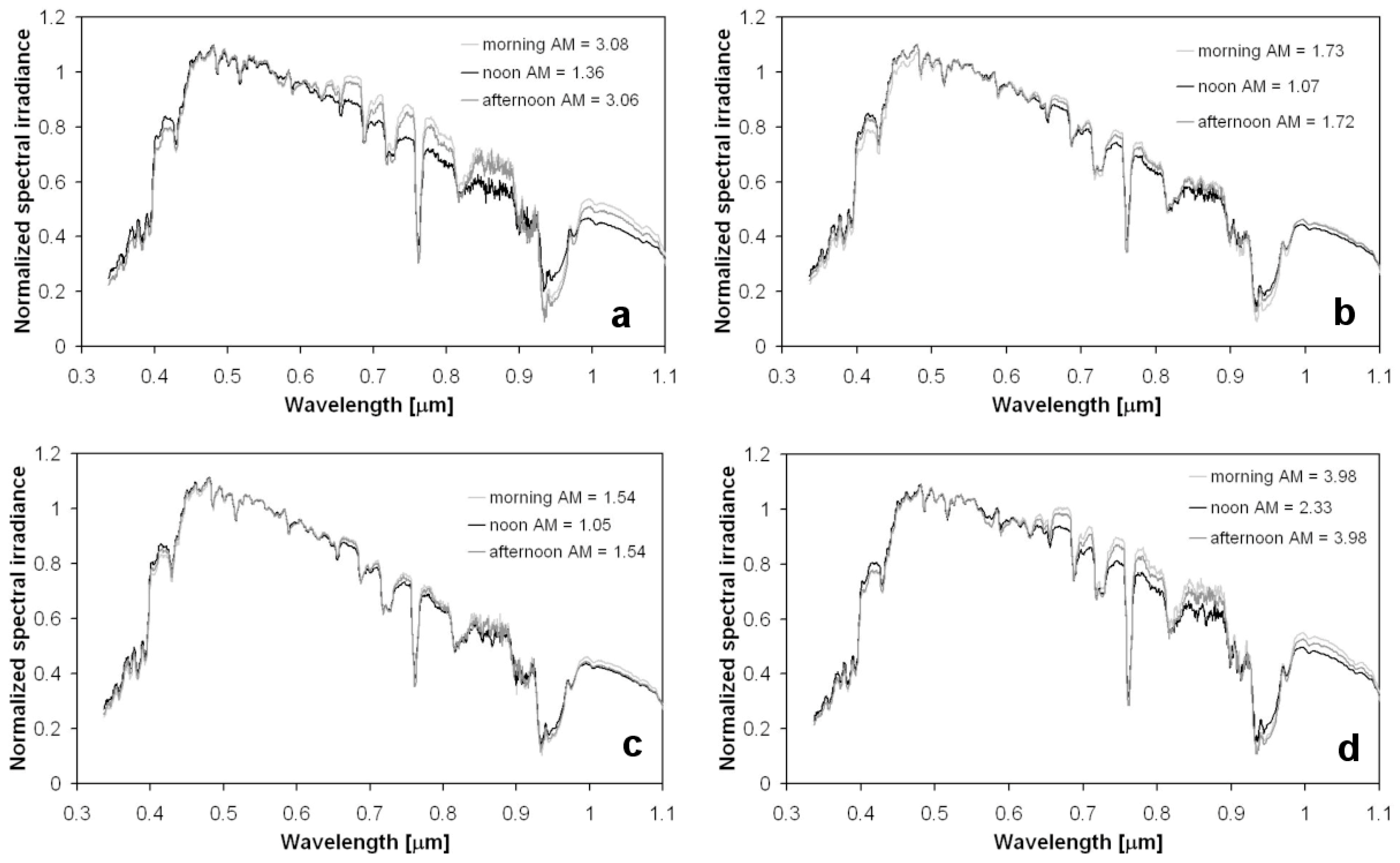

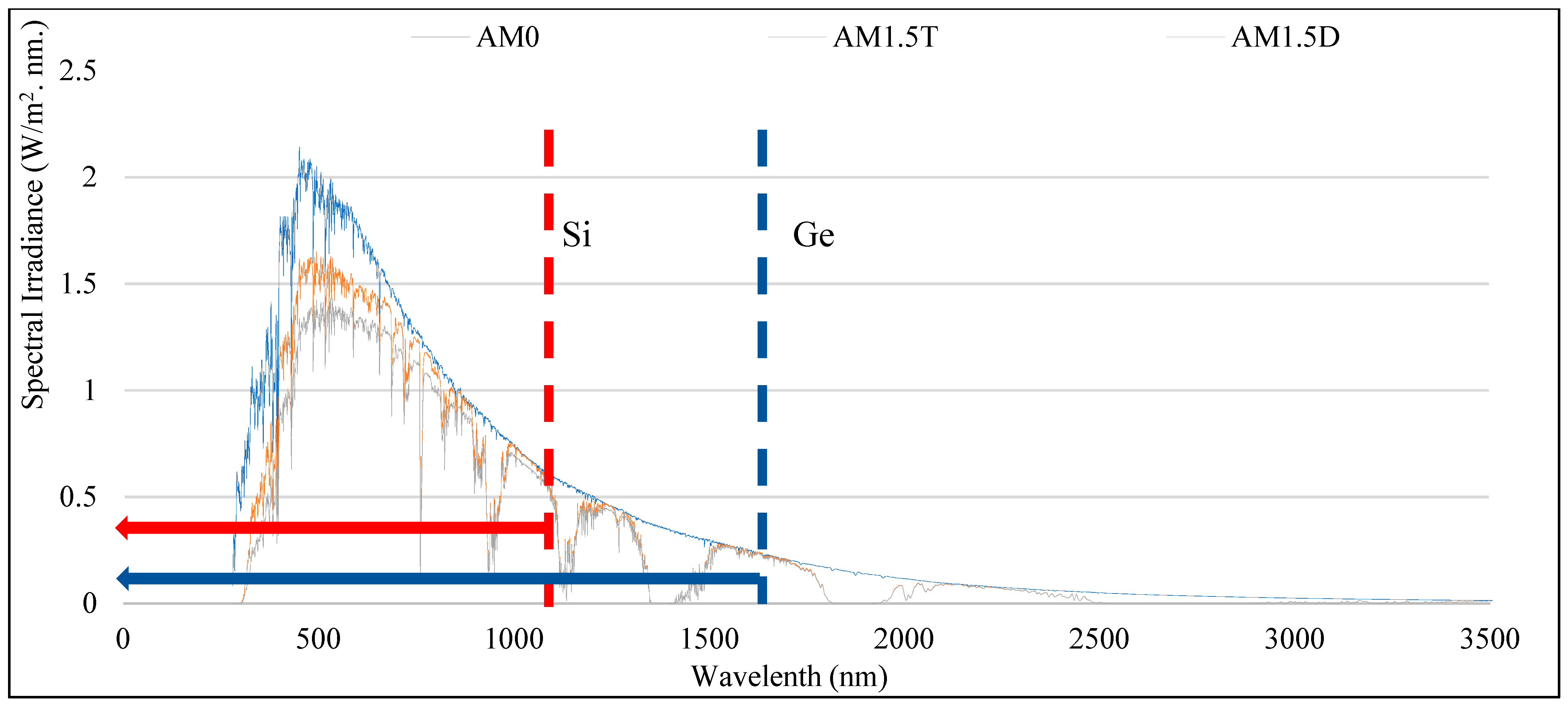

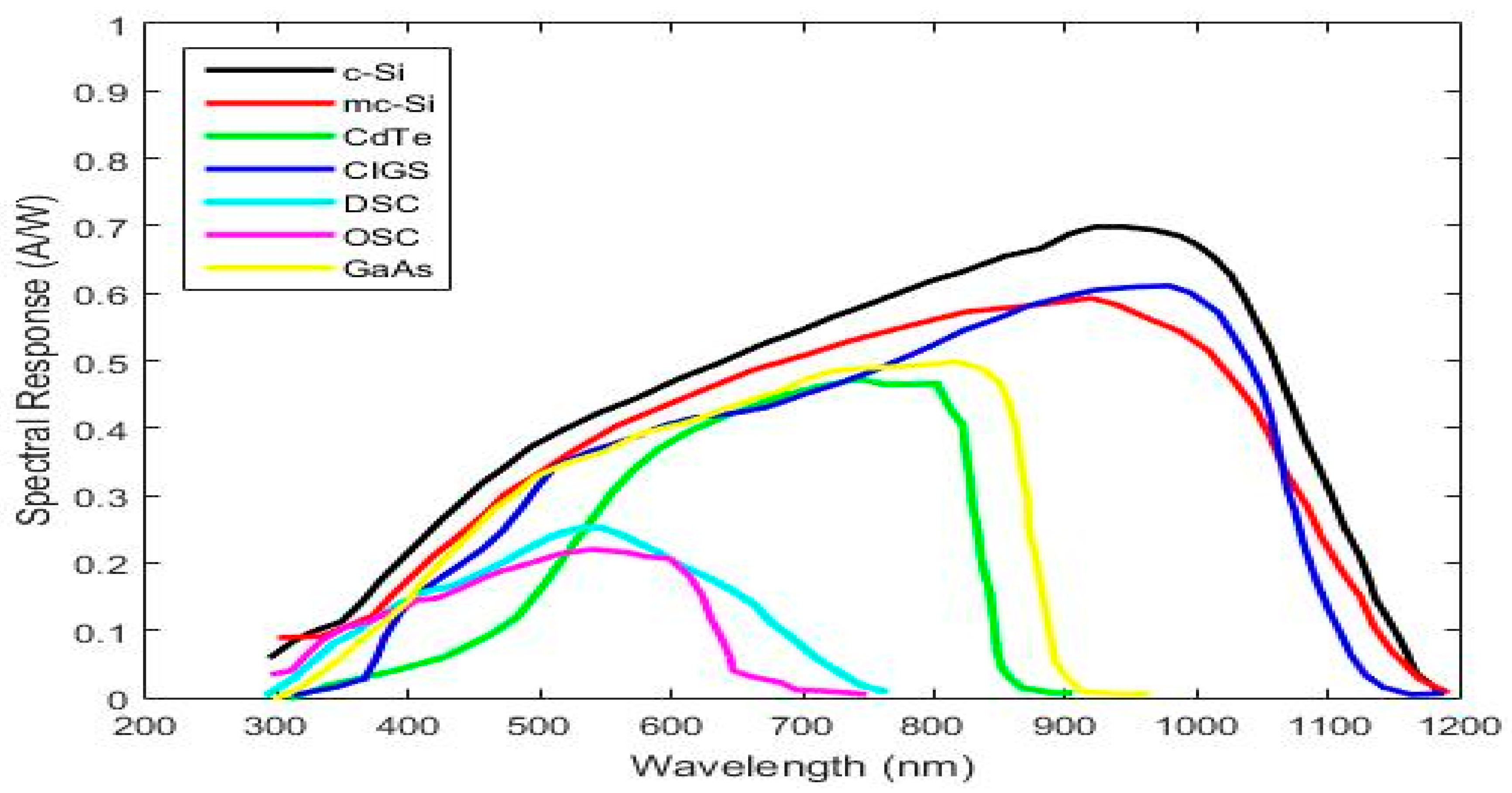
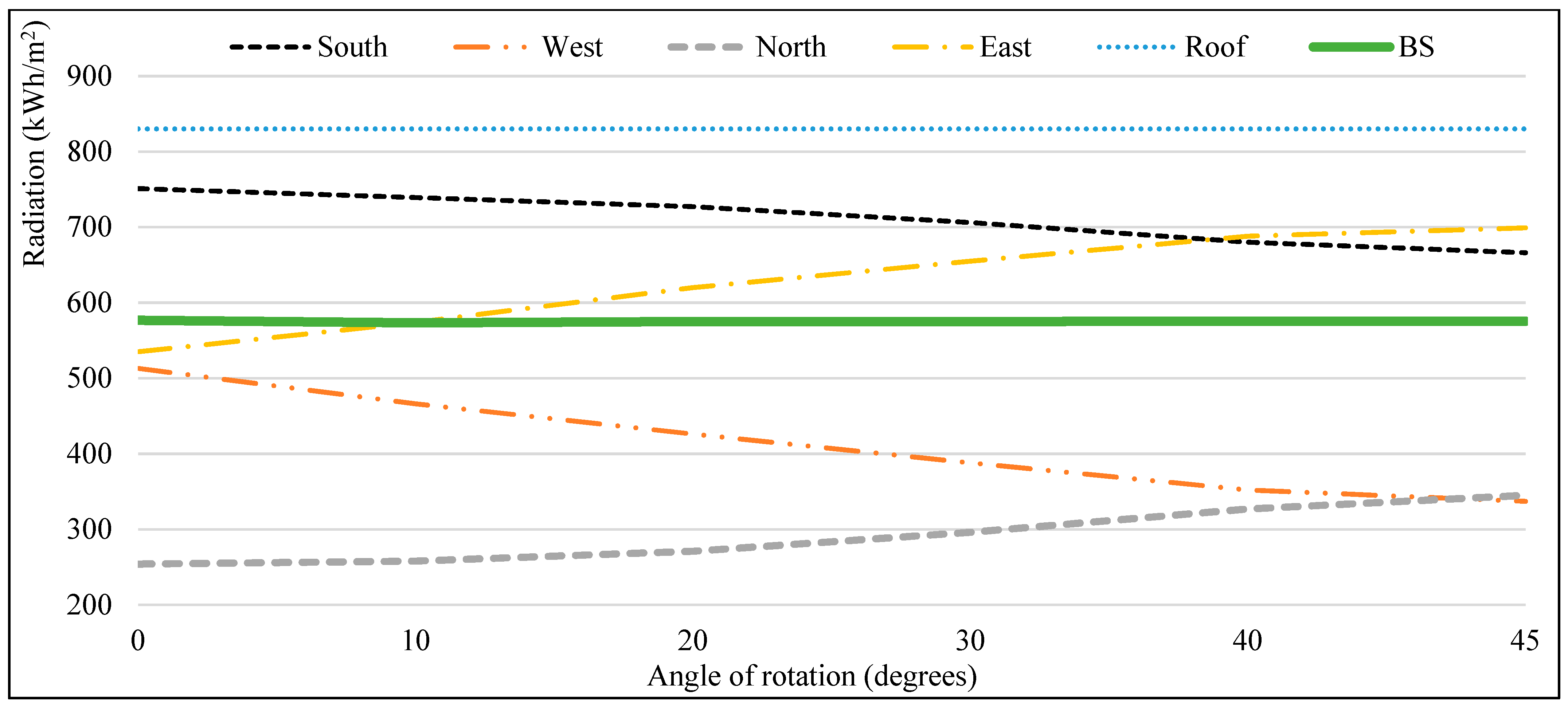
| City | Country | Latitude (Degree) | Longitude (Degree) | Altitude (Degree) |
|---|---|---|---|---|
| Stavanger | Norway | 58.96 | 5.73 | 15 |
| Bern | Switzerland | 46.94 | 7.45 | 542 |
| Rome | Italy | 41.90 | 12.49 | 32 |
| Dubai | UAE | 25.27 | 55.29 | 0 |
| City | Orientation | Total Radiation (kWh/m2) | Direct Radiation Contribution (%) | Diffuse Radiation Contribution (%) | Reflected Radiation Contribution (%) |
|---|---|---|---|---|---|
| Stavanger | South | 751 | 47% | 42% | 11% |
| East | 535 | 39% | 48% | 13% | |
| West | 513 | 38% | 49% | 13% | |
| North | 254 | 6% | 74% | 21% | |
| Roof | 831 | 40% | 60% | 0% | |
| BS | 577 | 38% | 52% | 9% | |
| Bern | South | 1138 | 56% | 32% | 11% |
| East | 816 | 50% | 38% | 12% | |
| West | 763 | 49% | 39% | 12% | |
| North | 296 | 8% | 71% | 21% | |
| Roof | 1334 | 58% | 42% | 0% | |
| BS | 869 | 51% | 40% | 9% | |
| Rome | South | 1340 | 59% | 29% | 12% |
| East | 959 | 53% | 35% | 12% | |
| West | 927 | 52% | 36% | 12% | |
| North | 315 | 10% | 70% | 20% | |
| Roof | 1676 | 65% | 35% | 0% | |
| BS | 1043 | 56% | 36% | 9% | |
| Dubai | South | 1344 | 52% | 32% | 16% |
| East | 1182 | 51% | 36% | 13% | |
| West | 1154 | 51% | 36% | 13% | |
| North | 433 | 11% | 67% | 22% | |
| Roof | 2311 | 68% | 32% | 0% | |
| BS | 1285 | 55% | 36% | 9% |
Publisher’s Note: MDPI stays neutral with regard to jurisdictional claims in published maps and institutional affiliations. |
© 2021 by the authors. Licensee MDPI, Basel, Switzerland. This article is an open access article distributed under the terms and conditions of the Creative Commons Attribution (CC BY) license (http://creativecommons.org/licenses/by/4.0/).
Share and Cite
Gholami, H.; Nils Røstvik, H. The Effect of Climate on the Solar Radiation Components on Building Skins and Building Integrated Photovoltaics (BIPV) Materials. Energies 2021, 14, 1847. https://doi.org/10.3390/en14071847
Gholami H, Nils Røstvik H. The Effect of Climate on the Solar Radiation Components on Building Skins and Building Integrated Photovoltaics (BIPV) Materials. Energies. 2021; 14(7):1847. https://doi.org/10.3390/en14071847
Chicago/Turabian StyleGholami, Hassan, and Harald Nils Røstvik. 2021. "The Effect of Climate on the Solar Radiation Components on Building Skins and Building Integrated Photovoltaics (BIPV) Materials" Energies 14, no. 7: 1847. https://doi.org/10.3390/en14071847







